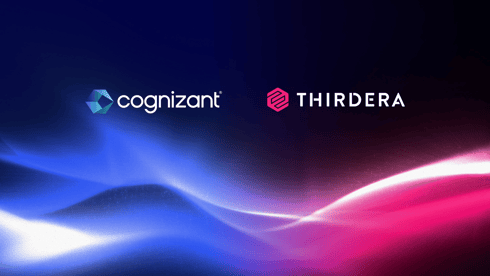Financial services, meet the future with...
Banks, credit unions, investment firms, and brokerages have relied on AI-driven tools for a longer period of time that almost any other business sector. It makes sense—large...
Read MoreThirdera generates transformation, digitization, and automation for our customers at the speed of NOW.
We help organizations adopt better patterns of work and get more from ServiceNow. Our team unlocks enterprise potential to elevate experiences across the world of work.
We help organizations adopt better patterns of work and get more from ServiceNow. Our team unlocks enterprise potential to elevate experiences across the world of work.

Exciting news! Thirdera and Cognizant Awarded Three ServiceNow Partner Specializations
Read more.jpg?width=500&height=276&name=filter%20group%20of%20people%20at%20desk%20laptop%20laughing%202021-10%20(1).jpg)


Insurance Provider Projects $75MM Gain in Business Value from Asset Management Transformation
Read more-1.jpeg?width=500&height=276&name=Indiana%20Department%20of%20Transportation%20Case%20Study%202023-03%20(3)-1.jpeg)
Government Agency INDOT Modernizes Its Constituent Service Model with CitizenKey
Read more.jpg?width=500&height=276&name=Multichannel%20pipette%20tips%20reaction%20mixture%20plastic%20wells%202022-05%20(1).jpg)

Balancing mission-driven goals with operational efficiency requires innovative solutions that can streamline processes, and enhance program delivery without straining budgets.

UN Agencies Rely on Thirdera and ServiceNow to Support the Ukrainian Aid Response
Read moreDigitize and automate workflows to enhance the customer experience, online and in-store.

.jpg?width=500&height=276&name=Servers%20data%20center%20room%20with%20bright%20speed%20light%202022-05%20(3).jpg)
Global SAP on Cloud Leader, Lemongrass, Embarks on Multi-Continent ITSM Overhaul
Read more

Stay up to date with the insights from ServiceNow experts and explore our blogs, news, case studies culture posts, partner updates and more.
Stay up to date with the insights from ServiceNow experts and explore our blogs, news, case studies culture posts, partner updates and more.


At the recent Knowledge23 conference one of our valued clients, Argonne National Laboratory, shared their amazing implementation story with ServiceNow Digital Portfolio Management (DPM): Down the rabbit hole: Argonne’s adventures with Digital Portfolio Management. Thirdera helped guide this journey by providing knowledge and advice on implementing and using DPM. If your organization is considering DPM, proper preparation, education, and awareness will make the journey smoother. Having been a lead advisor on Argonne’s DPM project, here are a few specifics I'd recommend you keep in mind as you prepare for your own DPM adventure.
The DPM application (formerly known as Service Owners Workspace) can be thought of as an aggregator of data, information, and knowledge about the health and status of services your organization provides. That data is pulled from the individual applications, modules, and tables that store the service records and related information. DPM gives service owners and leadership a single pane of glass view of several aspects of the service.
DPM pulls together what might at first seem like a lot of diverse and unconnected data, information, and knowledge. To make DPM bring this diverse data together requires an organization to travel into a “rabbit hole” that leads to the connections and relationships at the heart of ServiceNow.
Preparing to go down this rabbit hole begins with a clear understanding of the term “service” and which services your organization provides. A service is defined as:
“A means of enabling value co-creation by facilitating outcomes that customers want to achieve, without the customer having to manage specific costs and risks.”
This definition presents that services are not purely technologies, rather all the actions, information, and value propositions those services use and provide. In other words, services are constructs or logical entities that represent capabilities. These capabilities are the pinnacle of a taxonomy of information from the CSDM.
There are different types of services that are managed through several ServiceNow applications and modules. These include business services, technical services, systems, and others. Using DPM requires an understanding of these services and their associated applications. Because services are not physical things, rather actions we perform for customers, we need a way to manage, govern, and control the services that makes use of data, information, and knowledge about those services. That is the role and purpose of DPM.
As an organization prepares to use DPM to pull together the service information, there are steps that an organization must take:
Keep in mind that the information created and stored does not need to be perfect to begin using DPM. An organization can apply continual improvement and build the data over time to greater maturity. However, an organization will need some data and information about the services, metrics, CSAT, and other key inputs to start in DPM. Another factor to consider is that DPM requires service owners to take a top-down approach to CSDM, rather than the more traditional and comfortable CMDB upwards perspective. Once the organization makes the trip down this rabbit hole though, that top-down approach makes a world of sense.
With DPM being a relatively new ServiceNow product, you may find a need for additional information and resources. Thirdera can simplify the complex components of DPM to help you understand its best-use and functional value for your organization. Reach out to our ServiceNow experts to explore how DPM can harmonize multiple cross-departmental tools and enable your organization to seamlessly manage services from one place.
Banks, credit unions, investment firms, and brokerages have relied on AI-driven tools for a longer period of time that almost any other business sector. It makes sense—large...
Read MoreGrouping all patient care-related businesses under "the healthcare industry" is as oversimplified as describing our work as "something with AI." Thirdera, a Cognizant company,...
Read MoreThe ServiceNow Yokohama release became generally available on March 12, 2025, revolutionizing the NOW Platform with transformative enterprise AI capabilities. This release unifies...
Read MoreThe clock is ticking for organizations still running Windows 10. Microsoft has announced that Windows 10 will reach its end of support on October 14, 2025, meaning no more...
Read More